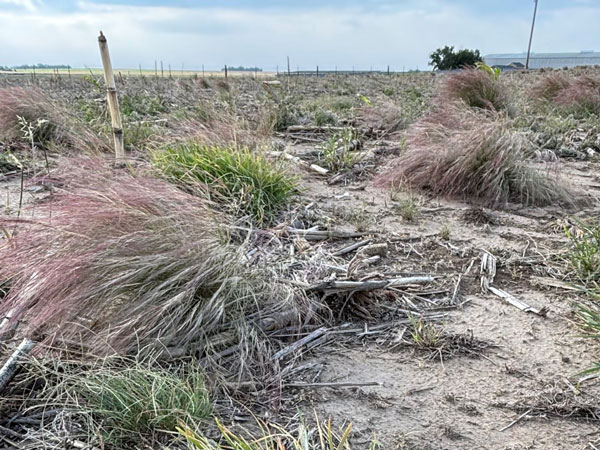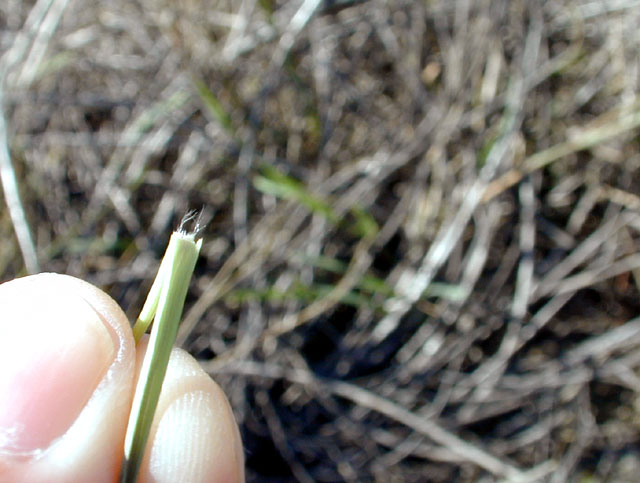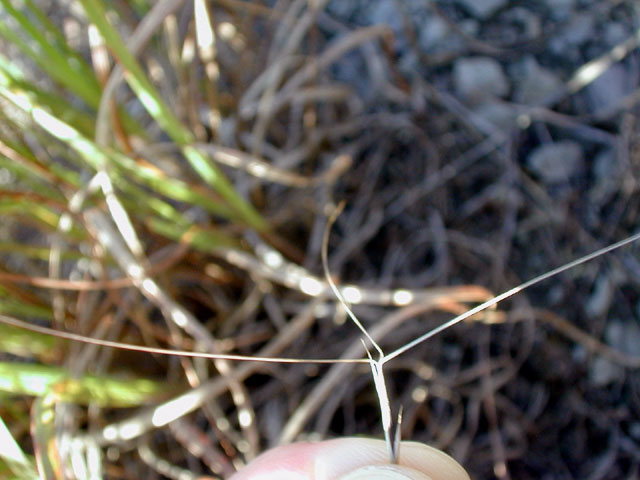Purple threeawn (Aristida purpurea) is a warm-season perennial grass native to Kansas and the Great Plains that can be a challenging weed in fields under long-term no-till management. This species may be found invading fields along with tumble windmillgrass and tumblegrass – other problematic native perennial grasses.
Ecology
Purple threeawn (Figure 1) is primarily found in the western 2/3 of Kansas and prefers dry sites with sandy or rocky soils. This grass readily reproduces by seed and invades disturbed sites or waste places. Because of its iconic awns that can cause eye, nose, and mouth injuries in livestock and wildlife, it is rarely eaten and is an indicator of overgrazing on rangelands.
Identification
Like tumble windmillgrass and tumblegrass, purple threeawn leaves are primarily located near the base of the plant, forming a clump. Leaves are rolled inward to flat and typically 12 inches long. They are rough textured and curved at maturity. The leaf sheath, mostly longer than the internodes, is round and slightly rough to smooth. The ligule consists of a short, fringed membrane, while the auricle (leaf collar) consists of long, tufted hairs (Figure 2).
Culms (stems) are erect, hollow, and six to 30 inches tall. Seed heads are narrow, often nodding, loose, purple to red panicles one and one half to 12 inches long. Spikelets have three nearly equal awns one to three inches long (Figure 3), from which this grass receives its common name.

Figure 1. Purple threeawn growing in fallow field in Finney County. Note the nodding purple to red seed heads. Photo by Logan Simon, K-State Research & Extension.

Figure 2. Purple threeawn ligule is a short and fringed membrane and the auricle is two tufts of long hairs on either side of the leaf blade. Photo by Mike Haddock, kswildflower.org.

Figure 3. Purple threeawn’s iconic spikelets have three nearly equal awns one to three inches long. Photo by Mike Haddock, kswildflower.org.
Management
Very little information is available on controlling purple threeawn in croplands, and unfortunately, very few herbicides are labeled for its control. Practices that avoid overgrazing can help prevent the invasion of rangelands. Research from USDA-ARS has shown that controlled burning can be an effective control strategy, with the greatest control from summer or fall burns.
An upcoming article will address the best management options for warm-season perennial grasses. Stay tuned!
The use of trade names is for clarity to readers and does not imply endorsement of a particular product, nor does exclusion imply non-approval. Always consult the herbicide label for the most current use requirements. Users should read and follow all label instructions.
Logan Simon, Southwest Area Agronomist, Garden City
lsimon@ksu.edu
Sarah Lancaster, Extension Weed Management Specialist
slancaster@ksu.edu
Jeremie Kouame, Weed Scientist – Agricultural Research Center, Hays
jkouame@ksu.edu